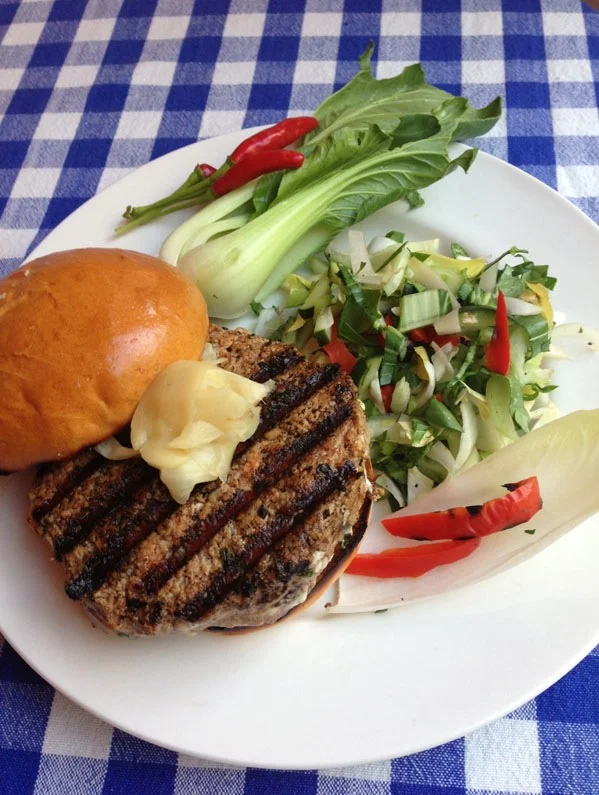A Guide to Turkey
FOR MY APPLE BRINE TURKEY RECIPE
Buying Guide: Allow 1 pound of turkey per person. I prefer to use young turkeys which are more tender; about 12-14 pounds vs. larger turkeys. If you need to serve a large group, cook two smaller turkeys, or roast an additional breast, drum sticks or wings as they will cook faster than cooking a large bird.
Self basted: (Not a preferred choice): Some turkeys are sold as "basted" or "self-basted," meaning they have been injected or marinated with a solution usually containing edible fat, natural broth, stock or water and seasonings. Self-basted turkeys are labeled with the percentage of the solution and its ingredients. Do not use self-basted turkeys when brining.
Conventional: Conventional turkeys are raised in scientifically designed, environmentally controlled barns that provide maximum protection from predators, disease and bad weather. They are given medications to prevent illness and to suppress organisms that are potentially harmful. This is the type of turkey that most Americans associate with Thanksgiving. These turkeys are typically sold fresh and frozen in supermarkets across the United States.
Free Range: The U.S. Department of Agriculture (USDA) says the term "free range" or "free roaming" can be used to describe poultry that "has been allowed access to the outside." There are a limited number of "free range" turkeys being produced and most of them are for the holiday season. There are fewer "free range" turkeys because of geographic and climatological considerations, making warm weather the most conducive for allowing birds access to the outside.
Organic: A turkey labeled "organic" has the approval and certification of the USDA. The government standard includes strict regulations on organic feed and free range access and allows no antibiotics. There are also fewer "organic" turkeys for some of the same reasons that there are fewer "free range" turkeys.
Broad-Breasted White: This is the most common type of turkey raised in the United States. This farm-raised domesticated turkey has been transformed in shape and size to meet the demands of consumer's taste preferences. This turkey yields a higher breast meat content, which is highly regarded by the U.S. consumer.
Heritage: The term refers to the turkey breeds indigenous to the Americas, dating to early Colonial times. They are Beltsville Small White, Bourbon Red, Jersey Buff, Narragansett, Royal Palm, Slate, Standard Bronze and White Holland. As a result of the market dominance of the conventional Broad-Breasted White, these breeds had been slowly shrinking in population. In 2001, Slow Food USA launched an initiative with the American Livestock Breeds Conservancy to work with small farms to return the heritage turkey to the marketplace. Heritage turkeys grow at a much slower rate than Broad-Breasted Whites. The result is a smaller bird with flavor some describe as gamy; and a thicker layer of fat surrounding the breast.
Fresh and Frozen Handling tips
Fresh Turkeys
-Keep it stored in the refrigerator until you're ready to cook it. Place it on a tray or in a pan to catch any juices that may leak.
-Do not buy fresh pre-stuffed turkeys. If not handled properly, any harmful bacteria that may be in the stuffing can multiply very quickly.
-Buy your turkey a few days before you plan to cook it.
Frozen Turkeys
-Turkey can be thawed in the refrigerator, or in cold water.
-Whole turkey takes about 24 hours per five pounds to thaw in the refrigerator. In cold water, changed water every 30 minutes; in water turkey takes about 30 minutes per pound to thaw.
-Never defrost turkey on the kitchen counter.
-Once thawed, keep turkey refrigerated at 40 degrees F. or below until it is ready to be cooked.
-Keep frozen until you're ready to thaw it.
-Turkeys can be kept frozen for six months, ideally up to one year.
Thawing Your Turkey
There are two ways to thaw your turkey safely — in the refrigerator or in cold water.
In the Refrigerator (40 °F or below)
Allow approximately 24 hours for every 4 to 5 pounds
4 to 12 pounds 1 to 3 days
12 to 16 pounds 3 to 4 days
16 to 20 pounds 4 to 5 days
20 to 24 pounds 5 to 6 days
Keep the turkey in its original wrapper. Place it on a tray or in a pan to catch any juices that may leak. A thawed turkey can remain in the refrigerator for 1 to 2 days. If necessary, a turkey that has been properly thawed in the refrigerator may be refrozen.
In Cold Water
Allow approximately 30 minutes per pound
4 to 12 pounds 2 to 6 hours
12 to 16 pounds 6 to 8 hours
16 to 20 pounds 8 to 10 hours
20 to 24 pounds 10 to 12 hours
Wrap your turkey securely, making sure the water is not able to leak through the wrapping. Submerge your wrapped turkey in cold tap water. Change the water every 30 minutes. Cook the turkey immediately after it is thawed. Do not refreeze.
FOR MY APPLE BRINE APPLE TURKEY RECIPE
chefgeorgehirsch.com







